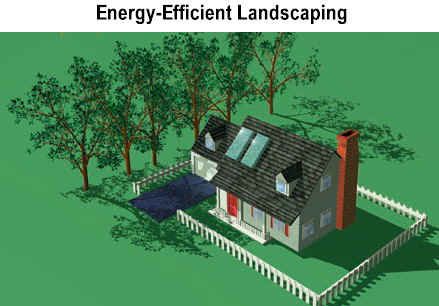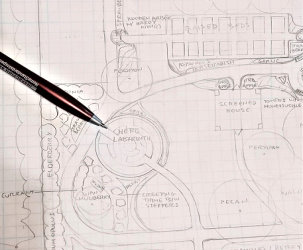There are many ways to reduce your ecological footprint with landscaping. Xeriscaping, Rainscaping, Windscaping, and shading are just a few options when it comes to reducing your pollution, as well as, energy and water use.
Xeriscape is a landscape installed with plant material that needs little to no water other than what Mother Nature provides (after it is established). This type of landscape reduces your water usage and tends to be fairly low maintenance as well. Using rocks, boulders and incredibly hardy plant material, you can achieve a wonderfully unique look for your landscape. Once a property is well xeriscaped and established, you really don’t have to worry much about fertilizing, watering, and all of the other care that tends to go along with typical landscaping.
Rainscaping: Where does your rainwater go? Rainwater comes from a lot of different places. Most people are aware that their roof is divided and rainwater is directed into several downspouts from their gutters. But where does this water go? If it isn’t traveling safely away from your foundation, walkways and driveways it can cause serious problems.
What people often don’t realize is how much water comes off of their roof in a typical 1″rain and also how much water comes from neighboring properties. Having a professional that can asses where water is coming from, how much is coming, and where it is going, is the first step in proper rainscaping. Once we know what the water is doing, we can direct it appropriately, in the most environmentally responsible way.
If your lawn is healthy and growing on well drained soil, it can usually accept a fair amount of rainwater. However, this is typically NOT the case. Most lawns are installed over top of compacted, clay soils and though it may appear healthy, the roots are all growing above this clay layer. This causes the lawn to require a lot more water in dry seasons, as well as extra fertilizers and care.
The health of the soil below your lawn is crucial, when it comes to the viability of your lawn. There are many ways of improving the soil below your sod, without taking out the entire yard and starting all over. In a perfect world, the sod should have 4″-6″ of healthy soil below it so that the roots can reach down to feed and water themselves. Most lawns usually have 2″ or less. Improving the soil not only reduces rainwater run-off, but it also saves you money in water and fertilizer.
How the ground drains is a very important factor in how to properly rainscape the property. If your lawn is like most, the water simply runs above the clay layer and onto the sidewalk or driveway (possibly underneath). If it is running straight onto these concrete areas, the result is that the unfiltered rainwater runs straight into our greywater sewers, which is then deposited directly into our waterways. There are many reasons why we don’t want to let that happen. The two main reasons are the amount of fertilizers and pesticides in runoff water, as well as the higher temperature of the water coming off of the concrete (thermopollution).
If we can slow down the running water, and allow it to slowly filter back into the soil, we can prevent both of these bad forms of pollution to our water sources. We have discussed Rainscaping on several of our pages, and this is because it is incredibly important. Handling our rainwater in an environmentally responsible way is one of the most important steps you can take in regards to pollution reduction.
Installing a good windbreak in just the right spot will not only reduce your power usage for heating your home, it will also make your ‘great outdoors’ a much more pleasant place to be. We recommend using a good variety of plant material instead of just one species for this purpose. Not only does it look better, it also has much more resistance to pests and diseases. If there is space, it is best to build a windbreak with three layers. The first layer being large shrubs and other attractive plantings to serve as the foreground. The second layer would consist of fast growing woody trees to quickly reach heights of 25′ or more. These are used to act as a temporary windbreak while the third layer is growing and filling in.
The third layer is the real workhorse (or it will be once it fills in to the right size). This should consist mainly of evergreens… But there are more options than just Pines. Fir, Spruce, Arborvitae, Junipers, as well as Pine trees are all very well suited to this climate.
Planting even one shade tree in the right spot can drastically reduce your electrical usage. Whenever possible it is best to get at least one, if not three, appropriately sized trees growing on the South-West side of your home. Deciduous trees are recommended because they offer the shade that you need in the hot months, and let the sunlight in through the colder months. Depending on the size of your yard, and the height of your house, there are thousands of tree varieties to choose from. With the right trees, you can not only increase your energy efficiency, but also add beauty with flowers and or fall color. Let us know how we can help you reduce your carbon footprint.
Whether we help you plant one tree, or install an entire landscape, we have the knowledge and experience to do it right. In the long run, a proper landscape will not only reduce your pollution and energy use, it will also save you money.








